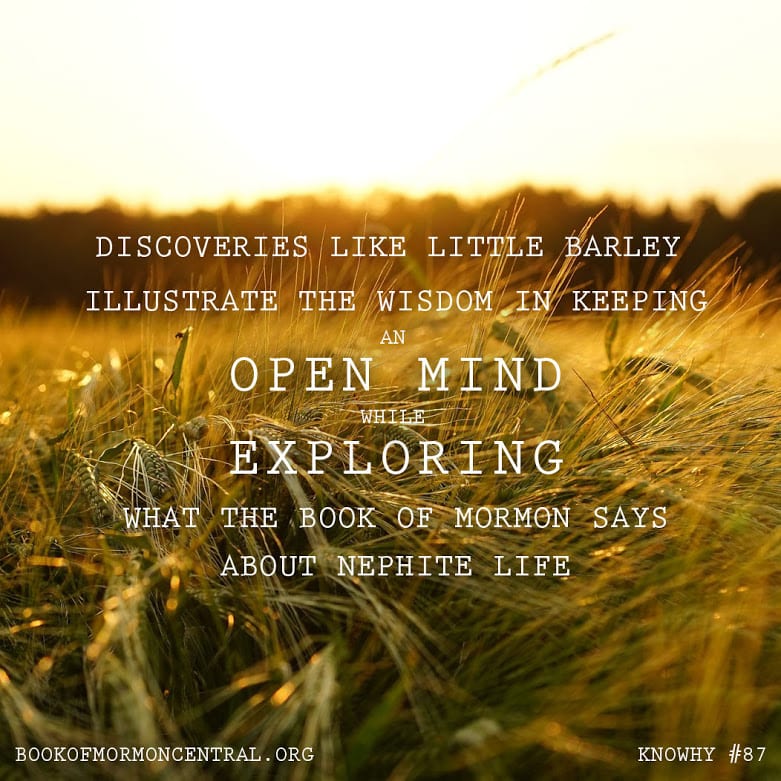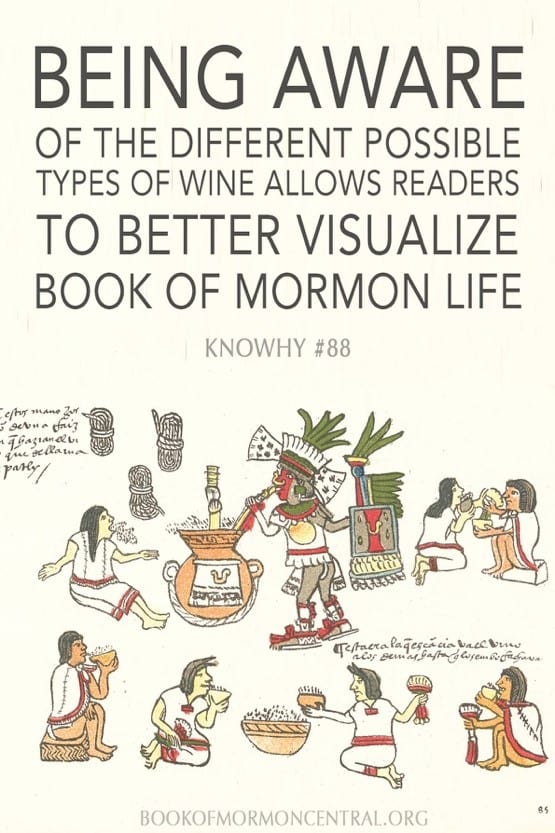“Knowing this, that the trying of your faith worketh patience” (James 1:3).
“But that on the good ground are they, which in an honest and good heart, having heard the word, keep it, and bring forth fruit with patience” (Luke 8:15).
We don’t typically think of patience as a gospel principle, even though it is mentioned 66 times in the Standard Works. Patience is a virtue, yes, but you are more likely to hear that old adage than a scripture reference when being told you’ll just have to wait for something you want right now. Yet, despite this, the fact is patience is a necessary component to faith.
The relationship of patience and faith can be illustrated well with the Book of Mormon and archaeology. Critics love to claim that there is no archaeological evidence for the Book of Mormon, and produce lists of plants, animals, and material culture items which are thought to be absent from ancient America to make their point. The pitfalls of negative evidence, however, are quickly apparent if we are we willing to step back and look at some examples.
Let’s start with barley. Barley is mentioned several times in the Book of Mormon, and was long considered an anachronism in the text. In 1983, however, domesticated barely was found in Arizona dating back to AD 900. When apologists first pointed this out, critics were slow to cede ground and nit-picked that this still was not old enough for Book of Mormon times.
Subsequent evidence has demonstrated that in native American “little barley” was cultivated as early as 800 BC, and in widespread use from 200 BC through AD 1000. Geographically, it is known in predominantly in the eastern United States, but archaeological findings also show it was cultivated in the southwest and Mexico. As Book of Mormon Central recently pointed out:
Over time, more and more evidence for domestication of little barley in the Americas has emerged over an increasingly wider span of both time and geography. Little barley may have diffused to other regions of the Americas which were known to trade with the southwest and eastern United States, including the exchange of crops. In any case, evidence demonstrates that in at least some parts of the Americas, a type of barley was a highly important crop during Book of Mormon times.
Some will still nit-pick and claim that the Book of Mormon requires old world barley, but unless one insists on a narrow interpretation of the text, that simply is not true. Barley no longer poses serious problems for the Book of Mormon, and that’s the weakness of negative evidence: a single discovery can change the picture. Book of Mormon Central gets it exactly right when they say “discoveries like little barley illustrate the wisdom in keeping an open mind and avoiding hasty judgments while considering and exploring what the Book of Mormon says about Nephite life.”
1983 was 153 years after the Book of Mormon was published, and all that time critics took advantage of the absence of barley; and right up until 1982, the absence of barely might have seemed pretty damning for the Book of Mormon. The value of patience here is clear.
The lesson learned from barely can be extended to other examples of common and long thought anachronisms. Consider wine, for instance. It is important to note that even in today’s vernacular, wine can refer to more than just fermented grape juice. Just google “apple wine,” “banana wine,” “pineapple wine,” and even “dandelion wine” to see my point. These kinds of “wines” were certainly known in pre-Columbian America. Book of Mormon Central explained: “Alcoholic beverages were made from a variety of fruits in the Americas before Columbus. These include bananas, pineapple, and agave, among others.” There were also native grapes, with some indication that it was used for wine-making.
Yet for the purposes of this post in illustrating the value of patience, I would like to highlight something else Book of Mormon Central mentioned: “There is also some evidence that the Old World grape was known and used for winemaking at one site in Chiapas, Mexico dating to between the first centuries BC and AD.” The evidence cited comes from a master’s thesis on an archaeological site in Chiapas (the region some geographers consider the land of Zarahemla) from 1978. It is less abundant, less widespread, and less well known than that of barley, but it is interesting nonetheless, and it follows the Book of Mormon by 148 years. Score one more for patience.
These kinds of examples are important to be aware of and keep in mind when dealing with some puzzles which are not so easily solved, like the horse. As Book of Mormon Central points out, there are certainly different possibilities, like loan-shifting and translator anachronisms that we ought to be open-minded about, but they are also keen to point out patience here as well. They note that there is some promising, yet inconclusive, evidence for horses in the Americas during Book of Mormon times. They then note, “it is best to be patient with the archaeological record. There is still much work to be done, and lots to be learned about life in pre-Columbian America.” Continuing on, they stress:
The vast majority of Mesoamerican ruins remain untouched underneath thick jungle growth, and other areas in the Americas have received even less attention. Also, the preservation of animal bones is very poor in the humid jungles of Mesoamerica. … Still, several items mentioned in the Book of Mormon once considered anachronistic have since been verified. This is why John E. Clark, a Latter-day Saint and prominent Mesoamerican archaeologist, declared: “the Book of Mormon looks better with age.” Such findings should urge caution against making final judgments based on absence of evidence.
Barley, and perhaps even wine, (to say nothing of Old World examples like Egyptian writing in Palestine, once thought to be an anachronism) illustrate this very point.
Other lines of evidence further encourage patience among believers. Little, if anything, was known about the ancient Mesoamerican practice of carving the history and achievements of kings on “large stones” in 1830, but now the scholarly understandings of such things converge nicely with the description in Omni 1:20–22. Or the way social stratification and polygamy functioned together in the middle pre-Classic (ca. 800–400 BC), providing a fitting context for Jacob’s sermon in Jacob 2–3. Or the lineage histories of various Mesoamerican cultures, which fit the Book of Mormon in both form and function. Or tumbaga and how the “golden” plates are consistent with this alloy. Or the way the conceptual purposes of Mesoamerican bloodletting are tied into the “atoning blood of Christ” and blended well with ancient Israelite understandings of blood sacrifice.
All of this does not even touch the Old World connections, generally seen as more abundant and persuasive. Things like the detailed understanding of ancient olive cultivation found in Jacob 5; the ancient legal practice of duplicating or abridging documents and then sealing a portion, just as the Book of Mormon plates were abridged and sealed; ancient Israelite festival and coronation tie-ins to Benjamin’s speech; the extensive use of poetic parallelisms common to Hebrew writing; the practice of subscriptio, which appears twice in the Book of Mormon; Sherem’s and Abinadi’s trials in light of ancient Israelite law; and on and on I could go. I’ve yet to mention the Nahom altars, which some critics act like is the only thing Mormon apologists ever talk about.
While there are certainly still lists of puzzling features that invite further thought and research, many things now known about both the ancient Near East and pre-Columbian Mesoamerica shed light and insight on the Book of Mormon. Why not focus on what evidence we do have rather than pine for the evidence that is missing? Few who jump on the Internet today are aware that the list of anachronisms is getting shorter. As John Clark said, the Book of Mormon truly does look better with age. This trend certainly endorses patience while grappling with persistent puzzles. Such patience has yielded abundant fruit over the last 186 years, and will likely to continue to yield even more.
Neal Rappleye is a Research Project Manager for Book of Mormon Central. He blogs on Latter-day Saint topics at http://www.studioetquoquefide.com/



